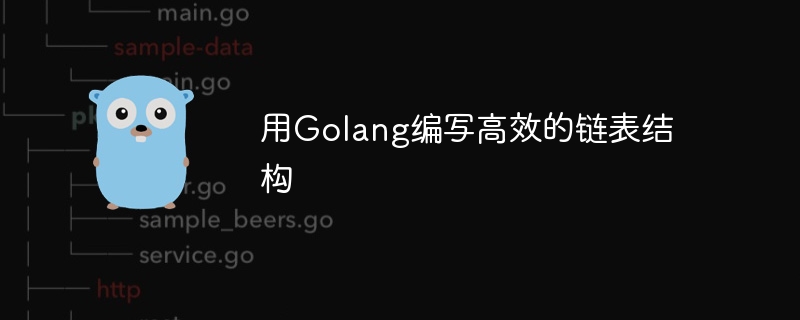
Golang是一門高效能的程式語言,它的並發能力和記憶體管理使得它非常適合編寫高效的資料結構。鍊錶是一種常見的資料結構,以下將介紹如何使用Golang編寫高效的鍊錶結構,並提供具體的程式碼範例。
鍊錶是一種線性資料結構,它由一個個節點組成,每個節點包含一個值和指向下一個節點的指標。相較於數組,鍊錶的優點在於插入和刪除元素的效率更高,因為不需要移動其他元素。然而,鍊錶的查找效率相對較低,因為需要從頭節點開始逐一存取。
首先,我們定義一個鍊錶節點的結構體,程式碼如下:
type Node struct {
value int
next *Node
}在鍊錶結構體中,我們定義了一個整數類型的值和一個指向下一個節點的指標。接下來,我們定義鍊錶結構體,包含一個頭節點和一個尾節點的指標。
type LinkedList struct {
head *Node
tail *Node
}現在我們可以實現鍊錶的一些基本操作,例如插入、刪除和尋找。以下是插入操作的程式碼範例:
func (list *LinkedList) Insert(value int) {
newNode := &Node{value: value}
if list.head == nil {
list.head = newNode
list.tail = newNode
} else {
list.tail.next = newNode
list.tail = newNode
}
}在插入操作中,我們先判斷鍊錶是否為空,如果為空,頭節點和尾節點都指向新節點。如果不為空,我們將新節點新增到尾節點後面,並將新節點設定為新的尾節點。
以下是刪除操作的程式碼範例:
func (list *LinkedList) Remove(value int) {
if list.head == nil {
return
}
if list.head.value == value {
list.head = list.head.next
if list.head == nil {
list.tail = nil
}
return
}
prev := list.head
current := list.head.next
for current != nil {
if current.value == value {
prev.next = current.next
if current == list.tail {
list.tail = prev
}
return
}
prev = current
current = current.next
}
}刪除操作先判斷鍊錶是否為空,如果為空則直接回傳。然後我們透過遍歷鍊錶找到要刪除的節點,在刪除節點之前儲存其前驅節點,然後將前驅節點的next指向待刪除節點的next。要特別注意的是,如果待刪除節點是尾節點時,需要更新鍊錶的尾節點。
最後,我們來實現鍊錶的查找操作:
func (list *LinkedList) Search(value int) bool {
current := list.head
for current != nil {
if current.value == value {
return true
}
current = current.next
}
return false
}查找操作很簡單,我們只需遍歷鍊錶並比較節點的值是否等於目標值。
現在我們已經實作了鍊錶的基本操作,可以透過以下程式碼範例來使用鍊錶:
func main() {
list := LinkedList{}
list.Insert(1)
list.Insert(2)
list.Insert(3)
fmt.Println(list.Search(2)) // Output: true
list.Remove(2)
fmt.Println(list.Search(2)) // Output: false
}以上就是使用Golang編寫高效的鍊錶結構的程式碼範例。鍊錶是一種重要的資料結構,掌握如何編寫高效的鍊錶實作對於解決實際問題非常有幫助。希望本文對你有幫助!
以上是建立高效能鍊錶結構,使用Golang編寫的詳細內容。更多資訊請關注PHP中文網其他相關文章!




